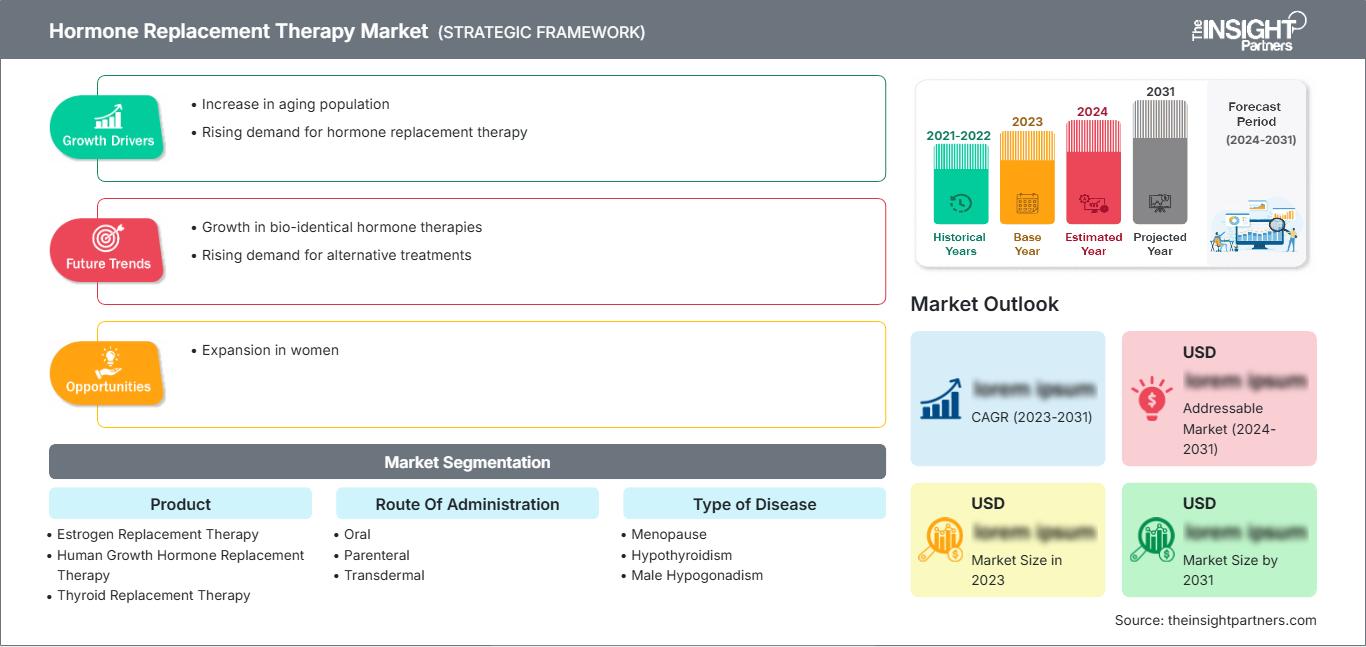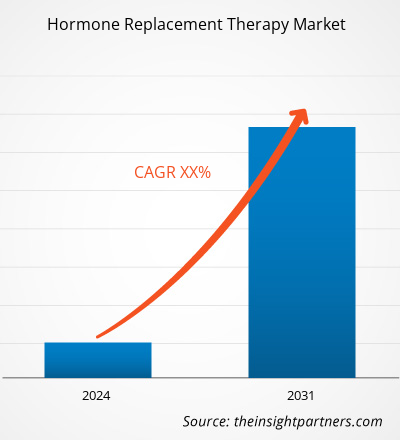Es wird erwartet, dass der Markt für Hormonersatztherapie (HRT) bis 2031 ein Volumen von 35,91 Milliarden US-Dollar erreichen wird. Für den Zeitraum 2025–2031 wird ein durchschnittliches jährliches Wachstum (CAGR) von 6,0 % prognostiziert.
Die weltweite Nachfrage nach Hormonersatztherapie (HRT) steigt stetig an. Gründe hierfür sind unter anderem die zunehmende Verbreitung von Hormonstörungen, das wachsende Bewusstsein für Hormonmängel und die Verbesserung von HRT-Präparaten. Aufgrund ihrer offensichtlichen Vorteile hinsichtlich Sicherheit und Wirksamkeit gewinnt die bioidentische Hormonersatztherapie (BHRT) gegenüber synthetischen Hormonen immer mehr an Beliebtheit. Da sie aus natürlichen Quellen stammt, ähnelt BHRT den Hormonen, die der Körper auf natürliche Weise produziert, vermutlich stärker.
Pharmaunternehmen investieren in die Entwicklung neuartiger Hormontherapie-Formulierungen, darunter transdermale Pflaster, Gele, Cremes und subkutane Implantate, um den Patientenkomfort, die Therapietreue und das Sicherheitsprofil zu verbessern. Dieser Faktor treibt das Wachstum des Marktes für Hormonersatztherapien voran. Im August 2023 genehmigte die US-amerikanische Arzneimittelbehörde FDA den verkürzten Zulassungsantrag (Abbreviated New Drug Application, ADA) von ANI Pharmaceuticals für ein 0,1%iges Estradiol-Gel. Das Referenzpräparat Divigel ist eine Östrogen-Hormontherapie zur Behandlung von mittelschweren bis schweren vasomotorischen Beschwerden in den Wechseljahren. Die generische Form von Divigel ist Estradiol-Gel (0,1%).
Wachstumstreiber:
Breites Anwendungsspektrum treibt das Wachstum des Marktes für Hormonersatztherapie an
Die Hormonersatztherapie (HRT) wird zur Behandlung von Wechseljahresbeschwerden, Wachstumshormonmangel usw. verschrieben, die das Leben einer Frau stark beeinträchtigen können. Millionen von Frauen nutzen HRT, teilweise über einen langen Zeitraum. HRT kann Osteoporose vorbeugen und die Lebensqualität in vielerlei Hinsicht verbessern. Laut der Oregon Health & Science University ist ein Wachstumshormonmangel (GHD) nicht häufig und betrifft in den USA etwa 50.000 Erwachsene und etwa eines von 4.000 bis 6.000 Kindern. Der zunehmende Einsatz der Therapie in Verbindung mit der steigenden Prävalenz verschiedener Hormonstörungen treibt somit das Wachstum des Marktes für Hormonersatztherapie an.
Zurückhaltung:
Hohe Medikamentenkosten hemmen das Wachstum des Marktes für Hormonersatztherapie
Die Kosten für Hormonersatztherapie-Produkte sind relativ hoch. So liegen beispielsweise die Preise für verschreibungspflichtige orale Hormonersatzpräparate laut dem Menopause Center zwischen 130 und 240 US-Dollar pro Monat (d. h. 1.560 bis 2.440 US-Dollar jährlich). Die hohen Kosten verhindern die regelmäßige Anwendung dieser Produkte und hemmen somit das Wachstum des Marktes für Hormonersatztherapie.
Sie erhalten eine kostenlose Anpassung aller Berichte – einschließlich Teilen dieses Berichts, Länderanalysen und Excel-Datenpaketen – sowie attraktive Angebote und Rabatte für Start-ups und Universitäten.
Markt für Hormonersatztherapie: Strategische Einblicke

-
Ermitteln Sie die wichtigsten Markttrends dieses Berichts.Diese KOSTENLOSE Probe beinhaltet eine Datenanalyse, die von Markttrends bis hin zu Schätzungen und Prognosen reicht.
Berichtssegmentierung und -umfang:
Die Marktanalyse für Hormonersatztherapie wurde unter Berücksichtigung der folgenden Segmente durchgeführt: Therapie, Anwendung, Verabreichungsweg und Endverbraucher.
Nach Therapieform ist der Markt für Hormonersatztherapie in Östrogen-, Wachstumshormon-, Schilddrüsenhormon- und Testosteronersatztherapie sowie weitere Therapien unterteilt. Das Segment der Östrogenersatztherapie hatte 2023 den größten Marktanteil.
Der Markt für Hormonersatztherapie wird nach Anwendungsgebiet in Wechseljahre, Wachstumshormonmangel, Schilddrüsenunterfunktion, Hypogonadismus und Sonstiges unterteilt. Das Segment Wechseljahre hielt 2023 den größten Marktanteil und wird voraussichtlich im Prognosezeitraum die höchste durchschnittliche jährliche Wachstumsrate (CAGR) verzeichnen.
Regionalanalyse:
Regional betrachtet umfasst der Bericht zum Markt für Hormonersatztherapie Nordamerika, Europa, den asiatisch-pazifischen Raum, Süd- und Mittelamerika sowie den Nahen Osten und Afrika. Nordamerika hielt 2023 den größten Marktanteil. Die zunehmende Nutzung neuester Technologien, die steigende Prävalenz von Hormonstörungen, die frühe Einführung neuer Produkte und die Präsenz wichtiger Marktteilnehmer tragen zum Wachstum des Marktes für Hormonersatztherapie in Nordamerika bei. Im Juni 2023 wurde NGENLA (Somatrogon-ghla), ein einmal wöchentlich zu verabreichendes Analogon des menschlichen Wachstumshormons, von der US-amerikanischen Arzneimittelbehörde FDA für die Behandlung von Kindern und Jugendlichen ab drei Jahren mit Wachstumsstörungen aufgrund unzureichender körpereigener Wachstumshormonproduktion zugelassen. Dies gaben Pfizer Inc. und OPKO Health Inc. in einer gemeinsamen Erklärung bekannt.
Darüber hinaus würde eine stärkere Fokussierung auf den Zugang zu hochwertiger, personalisierter Versorgung und die Stärkung der Gesundheitsversorgung im Prognosezeitraum erhebliche Chancen für den Markt der Hormonersatztherapie eröffnen. Im Mai 2023 wurde eines der größten Netzwerke von Hormonersatzkliniken in Texas, Hormones by Design, von Forum Health, LLC, dem ersten landesweiten Netzwerk von Anbietern für integrative und funktionelle Medizin, übernommen.
Markt für Hormonersatztherapie – Regionale Einblicke
Die regionalen Trends und Einflussfaktoren auf den Markt für Hormonersatztherapie im gesamten Prognosezeitraum wurden von den Analysten von The Insight Partners eingehend erläutert. Dieser Abschnitt behandelt außerdem die Marktsegmente und die geografische Verteilung des Marktes für Hormonersatztherapie in Nordamerika, Europa, Asien-Pazifik, dem Nahen Osten und Afrika sowie Süd- und Mittelamerika.
Berichtsumfang zum Markt für Hormonersatztherapie
| Berichtattribute | Details |
|---|---|
| Marktgröße im Jahr 2024 | US$ XX Milliarden |
| Marktgröße bis 2031 | 35,91 Milliarden US-Dollar |
| Globale durchschnittliche jährliche Wachstumsrate (2025 - 2031) | 6,0 % |
| Historische Daten | 2021-2023 |
| Prognosezeitraum | 2025–2031 |
| Abgedeckte Segmente |
Nebenprodukt
|
| Abgedeckte Regionen und Länder |
Nordamerika
|
| Marktführer und wichtige Unternehmensprofile |
|
Marktdichte der Akteure im Bereich der Hormonersatztherapie: Auswirkungen auf die Geschäftsdynamik verstehen
Der Markt für Hormonersatztherapie wächst rasant, angetrieben durch die steigende Nachfrage der Endverbraucher. Gründe hierfür sind unter anderem sich wandelnde Verbraucherpräferenzen, technologische Fortschritte und ein wachsendes Bewusstsein für die Vorteile des Produkts. Mit steigender Nachfrage erweitern Unternehmen ihr Angebot, entwickeln innovative Lösungen, um den Bedürfnissen der Verbraucher gerecht zu werden, und nutzen neue Trends, was das Marktwachstum zusätzlich beflügelt.

- Verschaffen Sie sich einen Überblick über die wichtigsten Akteure im Markt für Hormonersatztherapie.
Branchenentwicklungen und Zukunftschancen:
Die strategischen Entwicklungen führender Akteure auf dem Markt für Hormonersatztherapie sind laut den Pressemitteilungen des Unternehmens nachfolgend aufgeführt:
- Im Januar 2024 schlossen Ascendis Pharma A/S aus Dänemark und Vector Pharma FZCO (Vector) eine Exklusivvertriebsvereinbarung für die Vermarktung von Yorvipath und Skytrofa in den Staaten des Golf-Kooperationsrats (GCC) – Saudi-Arabien, Vereinigte Arabische Emirate, Kuwait, Oman, Katar und Bahrain. Gemäß dieser Vereinbarung wird Vector seine Vertriebs- und Marketingerfahrung nutzen, um Patienten in den GCC-Staaten Yorvipath und Skytrofa zur Behandlung von Hypoparathyreoidismus bei Erwachsenen bzw. von Wachstumshormonmangel (GHD) bei Kindern anzubieten.
Wettbewerbsumfeld und Schlüsselunternehmen:
AstraZeneca, Pfizer Inc., Novartis AG, Abbott, Tolmar Inc., Par Pharmaceutical, Mayne Pharma Group Limited, Novo Nordisk A/S, Eli Lilly and Company und Noven Pharmaceuticals, Inc. gehören zu den führenden Unternehmen, die im Marktbericht zur Hormonersatztherapie vorgestellt werden. Diese Unternehmen konzentrieren sich auf die Entwicklung neuer Technologien, die Verbesserung bestehender Produkte und den Ausbau ihrer geografischen Präsenz, um der weltweit steigenden Verbrauchernachfrage gerecht zu werden.
- Historische Analyse (2 Jahre), Basisjahr, Prognose (7 Jahre) mit CAGR
- PEST- und SWOT-Analyse
- Marktgröße Wert/Volumen – Global, Regional, Land
- Branchen- und Wettbewerbslandschaft
- Excel-Datensatz
Aktuelle Berichte
Erfahrungsberichte
Grund zum Kauf
- Fundierte Entscheidungsfindung
- Marktdynamik verstehen
- Wettbewerbsanalyse
- Kundeneinblicke
- Marktprognosen
- Risikominimierung
- Strategische Planung
- Investitionsbegründung
- Identifizierung neuer Märkte
- Verbesserung von Marketingstrategien
- Steigerung der Betriebseffizienz
- Anpassung an regulatorische Trends






















 Kostenlose Probe anfordern für - Markt für Hormonersatztherapien
Kostenlose Probe anfordern für - Markt für Hormonersatztherapien